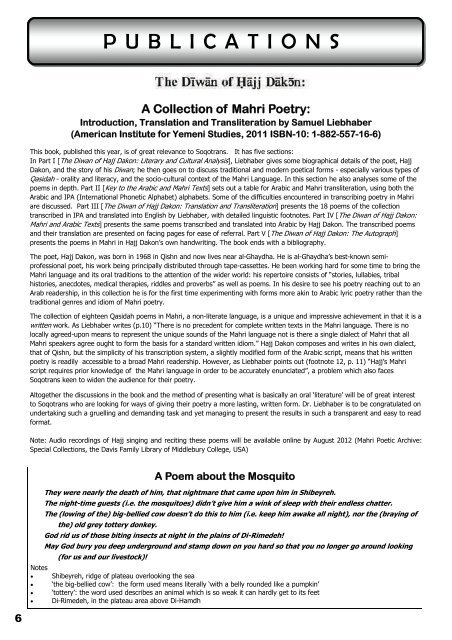TAYF the Soqotra Newsletter - Friends of Soqotra
TAYF the Soqotra Newsletter - Friends of Soqotra
TAYF the Soqotra Newsletter - Friends of Soqotra
Create successful ePaper yourself
Turn your PDF publications into a flip-book with our unique Google optimized e-Paper software.
6<br />
PUBLICATIONS<br />
A Collection <strong>of</strong> Mahri Poetry:<br />
Introduction, Translation and Transliteration by Samuel Liebhaber<br />
(American Institute for Yemeni Studies, 2011 ISBN-10: 1-882-557-16-6)<br />
This book, published this year, is <strong>of</strong> great relevance to <strong>Soqotra</strong>ns. It has five sections:<br />
In Part I [The Diwan <strong>of</strong> Hajj Dakon: Literary and Cultural Analysis], Liebhaber gives some biographical details <strong>of</strong> <strong>the</strong> poet, Hajj<br />
Dakon, and <strong>the</strong> story <strong>of</strong> his Diwan; he <strong>the</strong>n goes on to discuss traditional and modern poetical forms - especially various types <strong>of</strong><br />
Qasidah - orality and literacy, and <strong>the</strong> socio-cultural context <strong>of</strong> <strong>the</strong> Mahri Language. In this section he also analyses some <strong>of</strong> <strong>the</strong><br />
poems in depth. Part II [Key to <strong>the</strong> Arabic and Mahri Texts] sets out a table for Arabic and Mahri transliteration, using both <strong>the</strong><br />
Arabic and IPA (International Phonetic Alphabet) alphabets. Some <strong>of</strong> <strong>the</strong> difficulties encountered in transcribing poetry in Mahri<br />
are discussed. Part III [The Diwan <strong>of</strong> Hajj Dakon: Translation and Transliteration] presents <strong>the</strong> 18 poems <strong>of</strong> <strong>the</strong> collection<br />
transcribed in IPA and translated into English by Liebhaber, with detailed linguistic footnotes. Part IV [The Diwan <strong>of</strong> Hajj Dakon:<br />
Mahri and Arabic Texts] presents <strong>the</strong> same poems transcribed and translated into Arabic by Hajj Dakon. The transcribed poems<br />
and <strong>the</strong>ir translation are presented on facing pages for ease <strong>of</strong> referral. Part V [The Diwan <strong>of</strong> Hajj Dakon: The Autograph]<br />
presents <strong>the</strong> poems in Mahri in Hajj Dakon’s own handwriting. The book ends with a bibliography.<br />
The poet, Hajj Dakon, was born in 1968 in Qishn and now lives near al-Ghaydha. He is al-Ghaydha’s best-known semipr<strong>of</strong>essional<br />
poet, his work being principally distributed through tape-cassettes. He been working hard for some time to bring <strong>the</strong><br />
Mahri language and its oral traditions to <strong>the</strong> attention <strong>of</strong> <strong>the</strong> wider world: his repertoire consists <strong>of</strong> “stories, lullabies, tribal<br />
histories, anecdotes, medical <strong>the</strong>rapies, riddles and proverbs” as well as poems. In his desire to see his poetry reaching out to an<br />
Arab readership, in this collection he is for <strong>the</strong> first time experimenting with forms more akin to Arabic lyric poetry ra<strong>the</strong>r than <strong>the</strong><br />
traditional genres and idiom <strong>of</strong> Mahri poetry.<br />
The collection <strong>of</strong> eighteen Qasidah poems in Mahri, a non-literate language, is a unique and impressive achievement in that it is a<br />
written work. As Liebhaber writes (p.10) “There is no precedent for complete written texts in <strong>the</strong> Mahri language. There is no<br />
locally agreed-upon means to represent <strong>the</strong> unique sounds <strong>of</strong> <strong>the</strong> Mahri language not is <strong>the</strong>re a single dialect <strong>of</strong> Mahri that all<br />
Mahri speakers agree ought to form <strong>the</strong> basis for a standard written idiom.” Hajj Dakon composes and writes in his own dialect,<br />
that <strong>of</strong> Qishn, but <strong>the</strong> simplicity <strong>of</strong> his transcription system, a slightly modified form <strong>of</strong> <strong>the</strong> Arabic script, means that his written<br />
poetry is readily accessible to a broad Mahri readership. However, as Liebhaber points out (footnote 12, p. 11) “Hajj’s Mahri<br />
script requires prior knowledge <strong>of</strong> <strong>the</strong> Mahri language in order to be accurately enunciated”, a problem which also faces<br />
<strong>Soqotra</strong>ns keen to widen <strong>the</strong> audience for <strong>the</strong>ir poetry.<br />
Altoge<strong>the</strong>r <strong>the</strong> discussions in <strong>the</strong> book and <strong>the</strong> method <strong>of</strong> presenting what is basically an oral ‘literature’ will be <strong>of</strong> great interest<br />
to <strong>Soqotra</strong>ns who are looking for ways <strong>of</strong> giving <strong>the</strong>ir poetry a more lasting, written form. Dr. Liebhaber is to be congratulated on<br />
undertaking such a gruelling and demanding task and yet managing to present <strong>the</strong> results in such a transparent and easy to read<br />
format.<br />
Note: Audio recordings <strong>of</strong> Hajj singing and reciting <strong>the</strong>se poems will be available online by August 2012 (Mahri Poetic Archive:<br />
Special Collections, <strong>the</strong> Davis Family Library <strong>of</strong> Middlebury College, USA)<br />
A Poem about <strong>the</strong> Mosquito<br />
They were nearly <strong>the</strong> death <strong>of</strong> him, that nightmare that came upon him in Shibeyreh.<br />
The night-time guests (i.e. <strong>the</strong> mosquitoes) didn’t give him a wink <strong>of</strong> sleep with <strong>the</strong>ir endless chatter.<br />
The (lowing <strong>of</strong> <strong>the</strong>) big-bellied cow doesn’t do this to him (i.e. keep him awake all night), nor <strong>the</strong> (braying <strong>of</strong><br />
<strong>the</strong>) old grey tottery donkey.<br />
God rid us <strong>of</strong> those biting insects at night in <strong>the</strong> plains <strong>of</strong> Di-Rimedeh!<br />
May God bury you deep underground and stamp down on you hard so that you no longer go around looking<br />
(for us and our livestock)!<br />
Notes<br />
�� Shibeyreh, ridge <strong>of</strong> plateau overlooking <strong>the</strong> sea<br />
�� ‘<strong>the</strong> big-bellied cow’: <strong>the</strong> form used means literally ‘with a belly rounded like a pumpkin’<br />
�� ‘tottery’: <strong>the</strong> word used describes an animal which is so weak it can hardly get to its feet<br />
�� Di-Rimedeh, in <strong>the</strong> plateau area above Di-Hamdh


